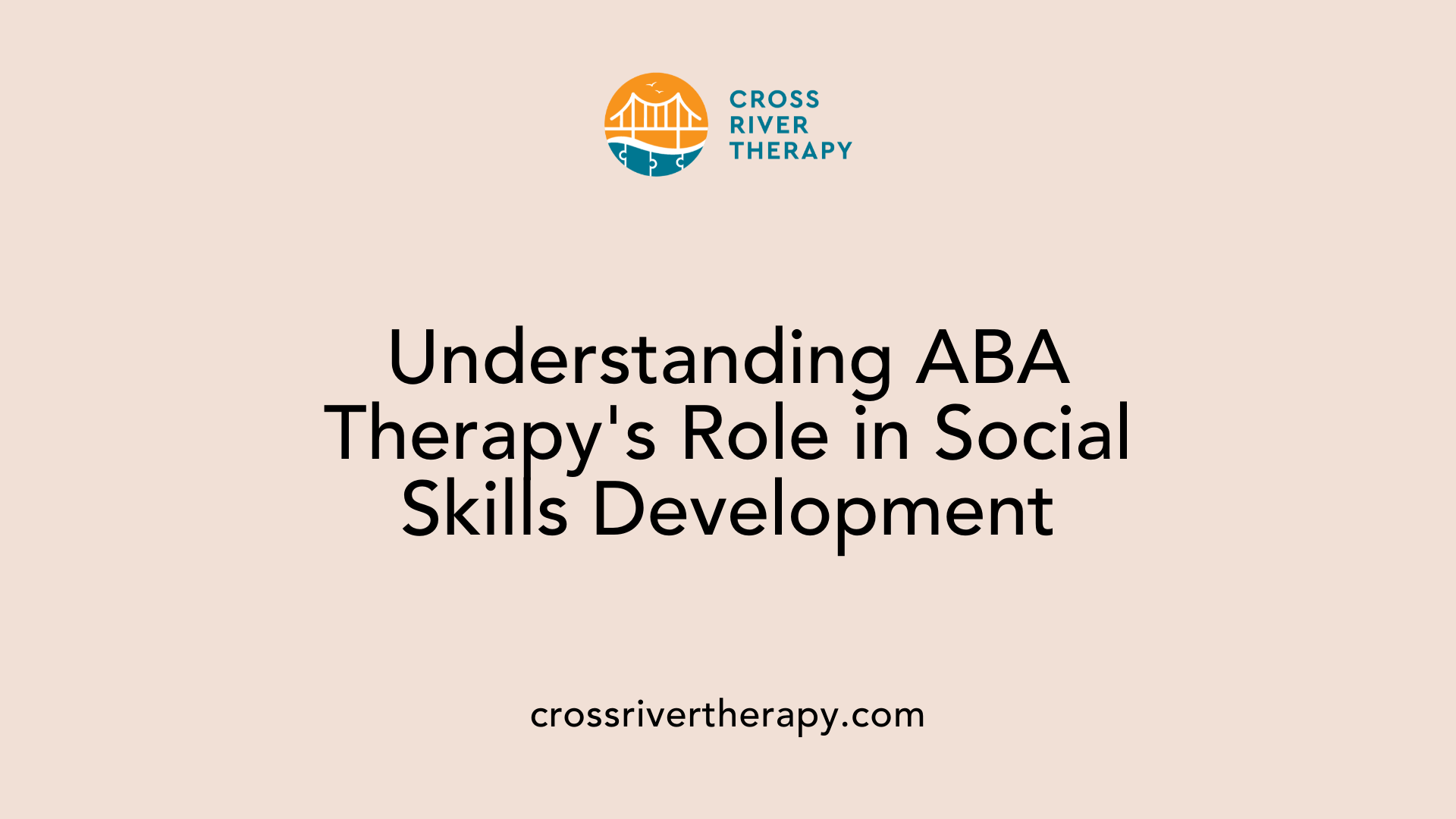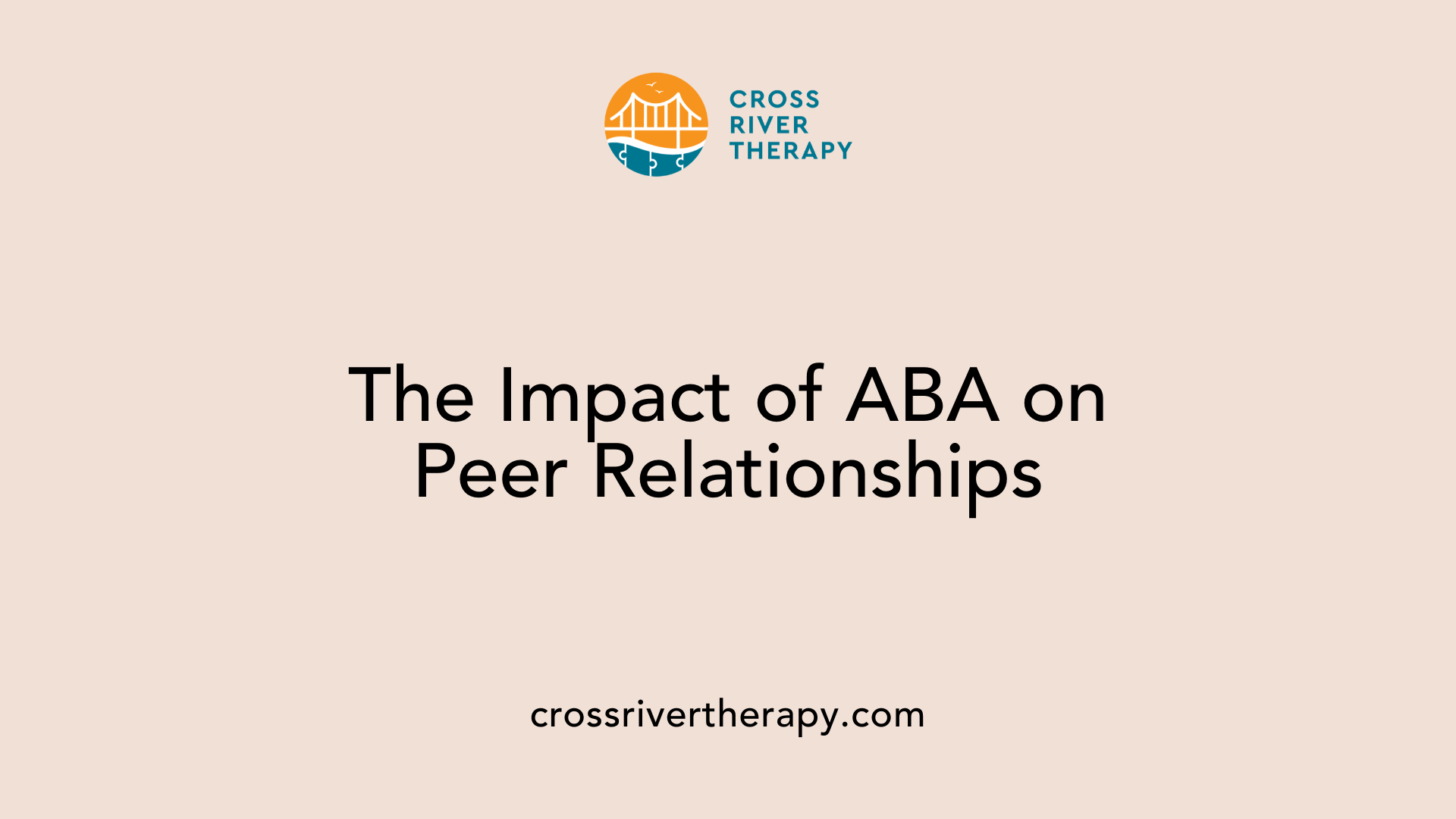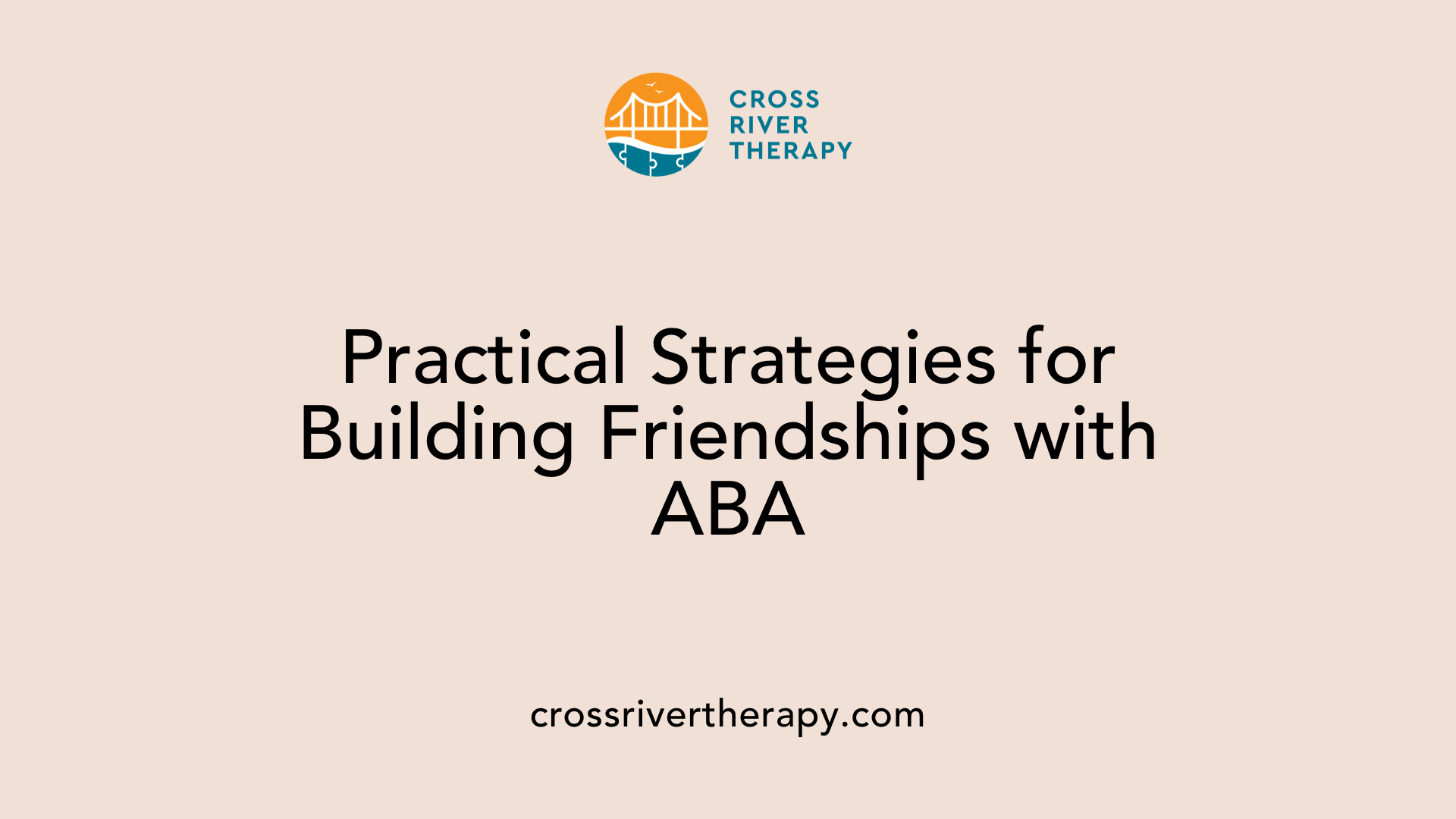How ABA Therapy Helps Children with Autism Build Relationships with Peers
Unveiling the Power of ABA Therapy in Enhancing Social Skills for Children with Autism
Understanding ABA Therapy's Role in Social Skill Development
Autism Spectrum Disorder (ASD) affects a child's ability to interact socially, often hindering the development of friendships and peer relationships. Applied Behavior Analysis (ABA) therapy emerges as a beacon of hope, providing evidence-based strategies to facilitate social interactions and support children with autism in building meaningful relationships with peers.
What is ABA Therapy and Its Impact on Social Skills

What is ABA therapy and how does it support social skill development in children with autism?
ABA (Applied Behavior Analysis) therapy is a scientifically validated approach designed to improve socially significant behaviors in children with autism. It employs principles of learning theory to break down social interactions into manageable tasks, allowing therapists to teach specific skills systematically.
Through ABA, children with autism can learn essential social skills such as initiating conversations, taking turns, and recognizing emotions. The method emphasizes reinforcing positive behaviors using rewards, which encourages children to engage in appropriate social interactions. This can result in enhanced communication both verbally and non-verbally, essential for building relationships with peers.
How ABA supports social skills
- Functional Behavior Assessment (FBA): This initial step identifies a child's unique needs, thus tailoring interventions to focus on specific deficits in social skills.
- Structured Sessions: Techniques like Discrete Trial Training (DTT) and Natural Environment Teaching (NET) ensure learning occurs in familiar contexts, promoting the generalization of skills.
- Positive Reinforcement: Encouraging desired behaviors makes it more likely that children will repeat those actions in social situations, fostering cooperation and interactions with peers.
- Repetitive Practice: Children benefit from frequent opportunities to practice social skills in a variety of settings, improving their ability to relate to peers over time.
- Peer-mediated Interventions: Teaching neurotypical peers to support children with autism enhances social integration and understanding, further improving social opportunities.
By addressing these areas, ABA therapy significantly aids in developing the social skills necessary for meaningful peer relationships.
Methodologies in ABA: Enhancing Communication

What methodologies are used in ABA therapy to enhance communication among children with autism?
ABA therapy employs various strategies such as:
Discrete Trial Training (DTT): This method breaks down skills into manageable parts, allowing children to learn through structured exercises and repetition. It’s effective for enhancing language and communication skills by focusing on specific targets in a controlled environment.
Pivotal Response Training (PRT): PRT focuses on teaching key pivotal behaviors that can lead to broader improvements in communication and social skills. It encourages children to engage in more natural interactions by promoting flexibility and initiative in communication.
Natural Environment Teaching (NET): This technique incorporates learning into familiar settings, enabling children to practice skills in their everyday lives. By learning in a natural context, children are more likely to generalize their skills across various situations and peers.
How can ABA therapy improve communication skills?
ABA fosters communication skill improvement by providing:
- Structured Learning Opportunities: Through structured play and interactive sessions, children practice taking turns, initiating conversations, and responding to social cues in a controlled yet flexible manner.
- Positive Reinforcement: Encouraging desired behaviors, such as sharing or making eye contact, using rewards promotes motivation, making it easier for children to engage socially with their peers.
- Visual Supports: Tools like social stories and visual models guide children in understanding social expectations and responses, simplifying abstract concepts into clear, concrete examples.
With these methodologies, ABA therapy significantly enhances communication skills, empowering children with autism to connect better with their peers.
Benefits of ABA in Building Peer Relationships

What are the benefits of ABA therapy in fostering peer relationships for children with autism?
ABA therapy provides numerous benefits to children with autism in developing peer relationships. One of the essential aspects of this approach is its focus on teaching specific social skills necessary for interacting effectively with peers.
Specific social skills taught
Children learn critical skills through structured activities in ABA, including:
- Taking Turns: Understanding the concept of sharing and the importance of waiting for one's turn in conversations and play.
- Interactive Play: Engaging in group activities that encourage collaboration and teamwork.
- Initiating Conversations: Using prompts to effectively start and maintain dialogues.
- Identifying Emotions: Recognizing emotions in themselves and others, fostering empathy.
- Recognizing Social Cues: Learning to interpret non-verbal signals such as body language and facial expressions.
Impact on peer interaction
The structured environment of ABA helps reduce anxiety, making social situations less overwhelming for children. By practicing these skills repeatedly in supportive settings, children gain confidence to engage with peers more naturally. Furthermore, positive reinforcement used in ABA allows children to experience success in their interactions, reinforcing desired behaviors and encouraging ongoing social engagement.
Incorporating these skills into everyday life through playdates, structured social opportunities, and peer-mediated interventions facilitates meaningful connections, ultimately leading to stronger friendships.
Real-Life Success Stories: ABA in Action

Are there any case studies or personal anecdotes that demonstrate ABA therapy's effectiveness in improving social interactions?
There are numerous compelling case studies illustrating the success of ABA therapy in enhancing social skills among children with autism. One notable example involves a child named Parker, who initially struggled with verbal communication and social engagement but experienced significant transformation after participating in ABA therapy at Hopebridge. Through structured interventions, Parker began to use two- and three-word phrases, enhancing his expressive language skills. This improvement not only boosted his confidence but also allowed him to form friendships, both with peers at the center and with his therapy team.
Another personal anecdote comes from parents who have witnessed substantial growth in their children’s ability to relate to others. They reported that using role-playing and visual aids during ABA sessions helped their children understand social cues better, facilitating smoother interactions during playdates. Structured environments like these provide opportunities for children to practice their social skills in a safe space, ultimately fostering a sense of community.
These stories highlight how ABA therapy employs tailored strategies that cater to each child’s needs, emphasizing the potential for positive outcomes in social engagement and peer relationships.
Practical Tips: Navigating Friendships with ABA

What are some practical tips and resources for helping children with autism navigate friendships and socialization using ABA strategies?
To effectively assist children with autism in developing friendships and improving their social skills, consider implementing the following practical tips:
Role-playing: This interactive method allows children to practice various social scenarios in a safe space. For instance, taking turns in a conversation or sharing toys can be modeled and practiced until the child feels more confident.
Visual aids: Utilizing tools like social stories and picture schedules can simplify complex social interactions. These visual guides help children understand social norms and expectations by illustrating appropriate behaviors in various contexts.
Structured playdates: Setting up playdates with a focus on guided activities can provide children with a framework to practice social skills. During these sessions, specific ABA strategies like positive reinforcement can be used to encourage successful interactions.
In addition to these strategies, resources such as specialized books, online communities, and support groups can offer valuable insights and support for parents and educators navigating socialization for children with autism.
Peer-Mediated Interventions: Enhancing Social Opportunities
What Are Peer Training Methods?
Peer training involves equipping neurotypical children with strategies to assist their peers with Autism Spectrum Disorder (ASD) in developing social skills. This method encompasses various activities such as:
- Guided Interactions: Structured play sessions where peers practice social skills with guidance.
- Modeling and Feedback: Using instructions that involve live demonstrations or video to show appropriate social behavior and provide constructive feedback.
- Repetitive Practice: Encouraging regular interaction among peers to reinforce learned skills, thus facilitating generalization in real settings.
How Do Peer Interactions Benefit Children with ASD?
Engaging neurotypical peers in training not only fosters improved understanding and empathy but also enhances social opportunities for children with ASD. These benefits include:
- Increased Joint Attention: Training helps develop both responding and initiating joint attention, crucial for forming friendships.
- Naturalization of Skills: Practicing in familiar environments, like schools and playgrounds, allows children to use their skills organically in daily interactions.
- Emotional and Social Growth: Regular peer interactions positively influence verbal and non-verbal communication, allowing for enriched engagements and lasting friendships.
In summary, peer-mediated interventions serve as a powerful tool in promoting social connections for children with ASD.
The Role of Technology in ABA Social Skills Training
Apps for Social Skills Development
Technology has emerged as a powerful ally in the realm of social skills training for children with autism. Apps designed specifically for developing social skills create controlled environments where children can practice social scenarios. These interactive tools often feature engaging content that captures the child’s attention, making learning enjoyable.
These applications allow children to explore various social situations, enabling them to understand and navigate complex dynamics in a playful manner. Visual aids within the apps, such as animated characters or storylines, help in reinforcing social skills while also offering opportunities for repetition and practice.
Technology's Impact on Social Scenarios
The impact of technology extends beyond just social skills practice; it also assists in building confidence in real-life interactions. Through the use of role-playing scenarios in applications, children can rehearse responses and better develop their verbal and non-verbal communication skills, crucial for engaging with peers.
Furthermore, technology facilitates joint attention techniques, where children with autism learn to share focus with their peers. This dual engagement not only enhances their understanding of social cues but also fosters deeper connections with others, which is vital for relationship building.
In summary, incorporating technology into ABA therapy for social skills not only makes learning accessible and fun but also promotes essential real-world interactions, paving the way for stronger peer relationships.
Empirical Research Supporting ABA Effectiveness
Empirical Studies on ABA Therapy
Applied Behavior Analysis (ABA) therapy has garnered extensive empirical support for its effectiveness in enhancing social skills among children with autism spectrum disorder (ASD). Research indicates that ABA not only increases communication abilities but also significantly improves social interaction skills. A pivotal focus of many studies is the examination of joint attention (JA) behaviors, crucial for forming friendships and social bonds. Reports show significant improvements in both responding to and initiating JA through structured peer training interventions.
Evidence-Based Approaches of ABA
ABA is recognized as an evidence-based approach that addresses various social skills deficits in children with autism. Techniques such as Discrete Trial Training (DTT) and Natural Environment Teaching (NET) break down interactions into manageable parts and promote skill generalization. Additionally, positive reinforcement strategies build desired behaviors, further facilitating effective peer interactions. Research continues to highlight the success of tailored programs in various settings, including schools and community programs, illustrating the importance of ongoing intervention in promoting long-term social development.
Conclusion: The Path to Meaningful Peer Connections
ABA therapy stands out as a pivotal approach in supporting children with autism in their journey toward forming meaningful peer relationships. By leveraging specialized methodologies, real-life applications, and technological advancements, ABA therapy provides the scaffolding necessary for children to achieve greater social integration and improve their quality of life. As parents and educators work hand-in-hand with therapists, ongoing support and tailored interventions ensure that every child has the opportunity to flourish socially.
References
- Fostering Peer Connections in Kids with Autism: Strategies
- Peer Training Can Help Children With Autism Spectrum Disorder
- Autism and Friendship: How ABA Therapy Helped Parker Make New ...
- Applied Behavior Analysis (ABA) | Autism Speaks
- The Role of ABA Therapy in Empowering Autistic Children and Their ...
- Increasing Joint Attention in Children with Autism and Their Peers
- Common ABA Therapy Strategies for Children With Autism
- How ABA Therapy Can Improve Social Skills
- The Effectiveness of ABA Therapy | Caravel Autism Health
- Peer Play: Facilitating Positive Social Interactions for Autism



